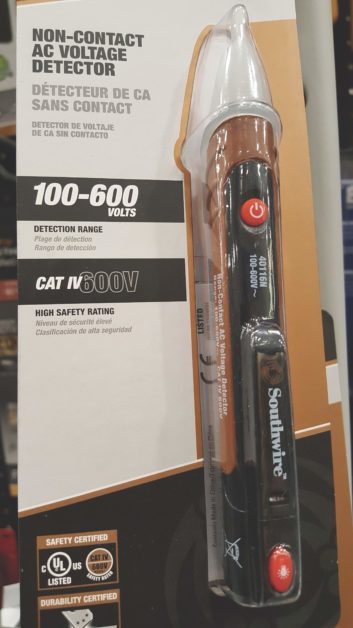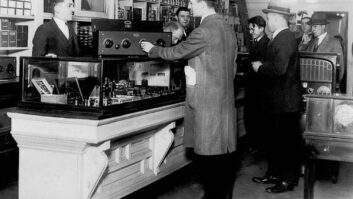
You may be familiar with Amprobe; for years they have manufactured a clamp-on ammeter, which you clamp around a wire to measure the current.
The company has released a product that detects leaks. It’s the ULD-420 Ultrasonic Leak Detector. The handheld detector is easy to use and provides an accurate location of an inaudible air or non-flammable gas leak. The detector can also identify vibrations and electrical discharge by picking up the ultrasonic sound produced by the leak or disturbance.
This product sounds like it is ideal for detecting transmission line air leaks, but the manufacturer says it can also be used on plumbing, heating and air conditioning systems, even motors or electrical systems. Read more at Amprobe.com; enter “ULD-420” in the search box.
***

I’m happy to report that big box stores like Lowes and Home Depot are now stocking the safety “volt pen” I discussed recently as a Telos representative on an SBE webinar. Head to the electrical aisle to pick up one of these lifesavers.
For those unfamiliar, it’s shown in Fig. 2. It’s an AC inductive probe that glows red when it senses AC voltage. Before reaching into any equipment, pass the volt pen around breakers and disconnects to ensure they are “off.” The version shown in the photo is a Southwire Non-Contact AC Voltage Detector, model 40116N. We also found it on Amazon.
***
Newman-Kees Principal Engineer Frank Hertel makes note of a relay contact transmitter and receiver pair that monitors eight separate switch contact input signals, and sends the status of each via an embedded device server to the matching relay output receiver. The combo costs under $900. Use it when you want to send contact switch or relay information over a Local Area Network or a wireless network link using TCP/IP protocol. The device is model IPG-8T and IPG-8R and you can get more information at www.fmsystems-inc.com/product/ipg-8tipg-8r.
While you’re on the site, click on the FM Systems Publications tab, then “Engineers Corner.” In addition to some interesting articles on relays and maximum cable lengths, read the article “When LEDs Act Like Photocells.” The article explains that in addition to providing an efficient light source, an LED can be used as a photocell to supply a voltage output that actually responds to the light levels in a room. It turns out that when light strikes the P-N junction of the silicon, electrons flow, generating a voltage, albeit a small one. You’ll find the article fascinating.
***
Frank also passed on an interesting note for engineers returning equipment for repair.
He and his son Dave provide equipment repair services at Newman-Kees. They have noticed that some products were shipped by UPS but with final delivery handed off to the US Postal Service. Many of these shipments arrived damaged.
This damage issue is not unique to Frank and Dave’s company. Other repair techs report similar instances of rough unconcerned handling. It appears to Frank that the problem is not UPS, but rather when the shipment is handed off to the USPS for final delivery. His suggestion is to instruct the UPS agent to ship UPS Ground (or UPS 3 Day Select, UPS 2 Day Air or UPS Next Day Air). Failure to stipulate a UPS service leaves it up to the agent to choose USPS Handoff Delivery, which saves UPS money.
So the bottom line is to be sure to specify one of the UPS services when shipping equipment, and ensure there is no handoff to USPS for final delivery.
***
Phil Florig, W9IXX, wrote to pass on a link to a small company that manufactures another version of the “walk the plank” mousetrap. Head to https://kentuckymousetraps.com/store to see several versions for both mice and rats. Phil just bought the rat version, we’ll wait for a report on its effectiveness.
***
Randall Davidson is the director of radio services at the University of Wisconsin/Oshkosh’s WRST(FM). Randall was pleased to see Dan Slentz’s submission about the Public News Service. Randall’s station uses it and has told others who are looking for a good, free news source.
Randall also wanted to tell you about another inexpensive option for stations to consider. Feature Story News offers hourly five-minute, three-minute and 30-second audio newscasts each weekday via download from stable URLs. The five-minute version is the three-minute offering plus “FSN Extra,” a 90-second feature on one topic. The last newscast on Friday evening is branded “Week in Review” and can be used throughout the weekend.
The network was founded in 1992 by former ITN reporter Simon Marks. They have reporters in 30+ bureaus around the world, providing video and audio packages for a variety of clients, and they offer this news service to radio stations for $15/month.
Randall uses a software package called Radio Spider to download the newscasts twice an hour and direct them to buttons in their playback system, so the content is always fresh. WRST has carried this service since 2011, and Randall says he couldn’t be happier with their service. For information, go to featurestorynews.com.
This is another opportunity for engineers to demonstrate their usefulness to the radio station. Let your manager know about this; the price will make the GM smile, and whether or not they use the service, it demonstrates your interest and involvement in all facets of the radio station.
***
With the New Year, set a goal and get certified by the SBE in 2020. Successful completion of any level of certification not only provides you with a professional certificate, but also a letter to your boss from the SBE, complimenting you on your achievement. An ideal combination for a salary review! Plus, recertification credit is provided to engineers who share a tip published in Workbench. Thank you for sharing your tips and high-resolution photos by sending them to [email protected].
John Bisset has spent 50 years in the broadcasting industry and is still learning. He handles western U.S. radio sales for the Telos Alliance. He holds CPBE certification with the Society of Broadcast Engineers and is a past recipient of the SBE’s Educator of the Year Award.












